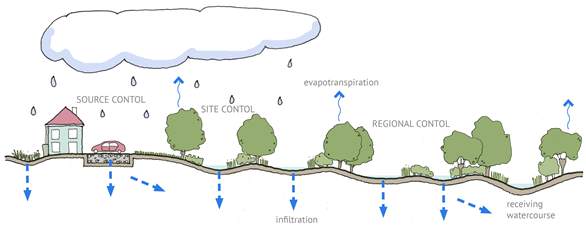- Delivering SuDS
- Using SuDS
- Background
- SuDS principles
- Benefits of SuDS
- Benefits of SuDS
- Why developers should choose SuDS
- Flood risk management
- Water quality management
- Biodiversity & ecology
- Amenity
- Air quality
- Building temperature
- Carbon reduction and sequestration
- Crime
- Economic growth
- Enabling development
- Flexible infrastructure/climate change adaptation
- Education
- Groundwater recharge
- Health and well being
- Pumping wastewater
- Rainwater harvesting
- Recreation
- Tourism
- Traffic calming
- Treating wastewater
- SuDS components
- SuDS components overview
- Source control
- Swales & conveyance channels
- Filtration
- Infiltration
- Retention & detention
- Wetlands
- Inlets, outlets and control structures
- SuDS performance & monitoring
- Delivery
- The costs & benefits of SuDS
- Adoption & maintenance of SuDS
- Legislation & regulation
- Design guidance
- Retrofitting SuDS
- Drainage exceedance
SuDS management train
A useful concept used in the development of sustainable drainage systems is the SuDS management train (sometimes referred to as the treatment train), illustrated below. Just as in a natural catchment, drainage techniques can be used in series to change the flow and quality characteristics of the runoff in stages.
The management train starts with prevention (preventing runoff by reducing impermeable areas), or good housekeeping measures for reducing pollution; and progresses through local source controls to larger downstream site and regional controls.
Runoff need not pass through all the stages in the management train. It could flow straight to a site control, but as a general principle it is better to deal with runoff locally, returning the water to the natural drainage system as near to the source as possible.
Only if the water cannot be managed on site should it be (slowly) conveyed elsewhere. This may be due to the water requiring additional treatment before disposal or the quantities of runoff generated being greater than the capacity of the natural drainage system at that point. Excess flows would therefore need to be routed off site.
End of pipe solutions where runoff is directly discharged to a wetland or pond should be avoided where possible, as these end of pipe components are likely to larger more expensive and potentially receive faster runoff flows and higher levels of pollution. SuDS design requires a balancing of different options, often depending on the risks associated with each course of action. The risks of an area flooding have to be balanced with the costs of protecting the area from different levels of floods.
The management train concept promotes division of the area to be drained into sub-catchments with different drainage characteristics and land uses, each with its own drainage strategy. Dealing with the water locally not only reduces the quantity that has to be managed at any one point, but also reduces the need for conveying the water off the site.
When dividing catchments into small sections it is important to retain a perspective on how this affects the whole catchment management and the hydrological cycle.
Read more on:




